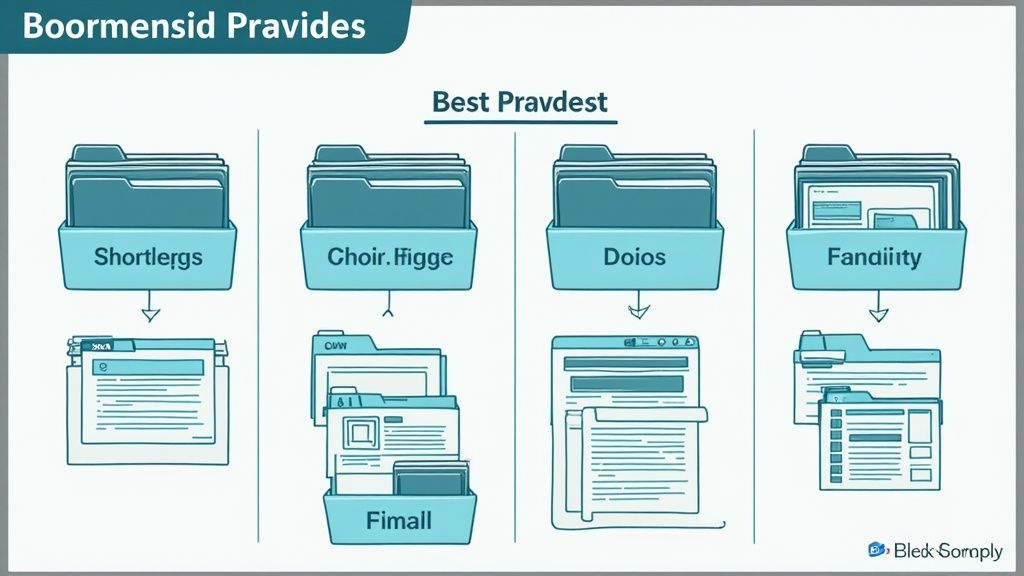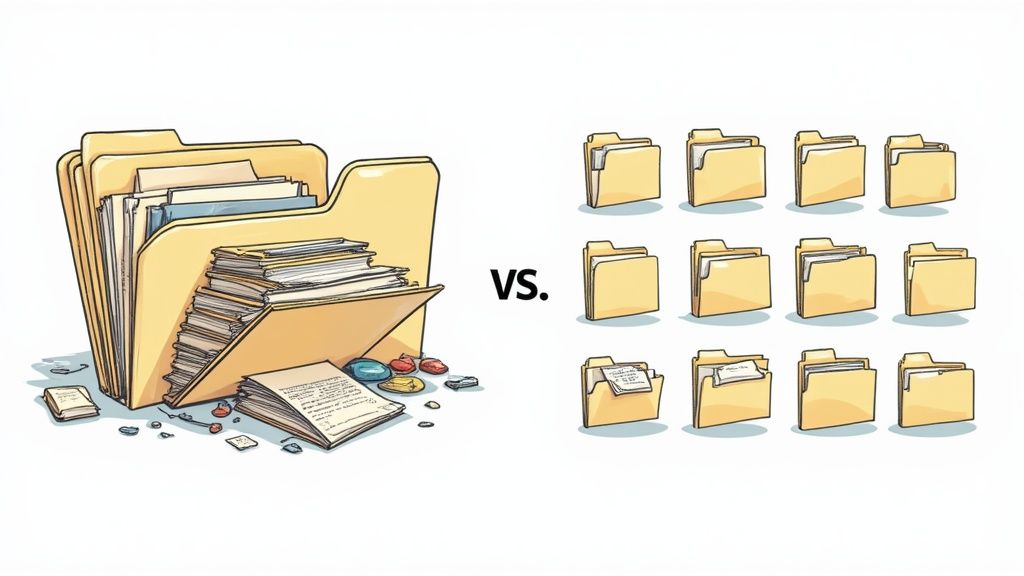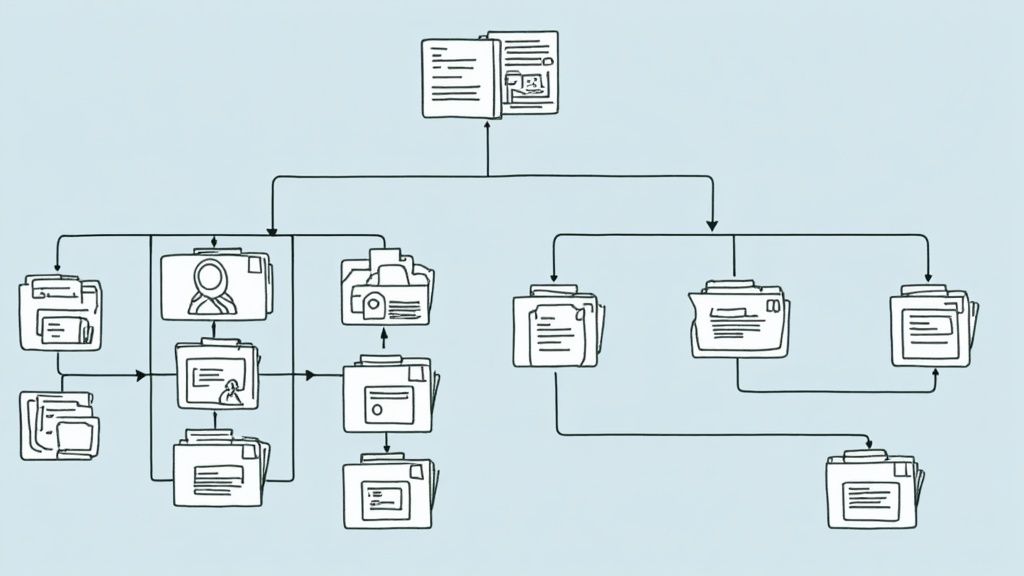Folder Structure Best Practices: A Complete Guide to Modern File Organization
Understanding the New Era of File Organization

Good file management is essential for any project or organization. As teams grow and data volumes increase, traditional folder structures often become messy and hard to navigate. This makes it crucial to develop better ways to organize and access files.
Why Traditional Methods Fail
Most basic folder structures simply sort files by date created, ignoring their purpose or project relevance. This approach quickly breaks down, especially in larger teams. Finding specific files becomes frustrating and wastes valuable time that could be spent on actual work.
The Impact of Organized Files
A clear, logical folder structure helps teams work better together. When everyone knows where to find what they need, projects move forward smoothly. Good organization also prevents common issues like duplicate files and version mix-ups that plague disorganized teams.
Key Principles for Modern File Organization
The best file systems are built on three core principles: accessibility, scalability, and maintainability. Files should be easy to find, the system should grow smoothly with your team, and updates should be simple to make. One key tip is keeping folder depth to three levels or less - this prevents endless clicking through nested folders.
Here's a practical example: A research project might have main folders for 'Data Files', 'Project Admin', and 'Images', with relevant subfolders inside each. This makes it quick and obvious where different types of files belong. Want to learn more about organizing your files? Check out these data organization best practices.
Building a Foundation for Success
Taking time to set up good folder structure pays off. When teams spend less time hunting for files, they can focus more on meaningful work. This leads to better project results and helps the whole organization run more smoothly. With these basics covered, let's look at how to create a folder system that works for your needs.
Building a Scalable Folder Framework That Actually Works

A scalable folder framework does more than just store files - it grows and adapts with your needs. By planning ahead, you can create a system that handles increasing data volumes while keeping everything organized and easy to find. Let's look at the key elements that make folder structures work well over time.
Categorization and Metadata: The Foundation of Findability
Good organization starts with clear categories. Create main folders like "Projects," "Marketing," and "Finance," then add relevant subfolders within each one. For example, your "Projects" folder might contain individual project folders, each with sections for documents, images, and other files.
Adding metadata like tags and descriptions makes files much easier to find later. Even if you forget a file's exact name or location, you can search using keywords to track it down quickly. This is especially helpful when using digital asset management systems that support advanced search features. Learn more about folder organization.
Naming Conventions: Creating Order From Chaos
Clear naming conventions help everyone understand what's in a folder at first glance. Using consistent date formats (like YYYYMMDD) automatically sorts files by time. Including project codes or client names adds another way to organize and find files quickly. This simple step prevents confusion and saves time searching for documents.
Want to learn more about managing your files? Check out our guide on file compression techniques.
Version Control: Protecting Against Costly Errors
Good version control is essential when multiple people work on files. Label different versions clearly (like "Document_v1," "Document_v2") to prevent accidentally overwriting important work. This creates a clear history of changes and helps avoid mistakes that could cost time and effort to fix.
Regular reviews of your folder system help keep it working well as your needs change. Set aside time to clean up and reorganize when needed, ensuring your framework stays useful long-term.
Creating File Naming Conventions That Transform Workflows
Clear file naming makes a huge difference in keeping folders organized. When everyone follows the same naming rules, it becomes much easier to find files quickly and keep track of different versions. Good naming systems help teams work faster and make fewer mistakes.
Why Standardized Naming Matters
Think about trying to find one specific photo in a folder with hundreds of randomly named images. Pretty frustrating, right? That's why having standard naming rules is so important. When files follow a clear pattern, you can find what you need right away instead of wasting time searching. This becomes especially important when teams need to access files quickly.
Building a Robust Naming Convention
The best file names are both clear and brief. Here are the key elements to include:
- Descriptive Keywords: Pick words that clearly show what's in the file. Example: "ProjectX_MarketingReport_2024_Final.pdf" tells you the project, type of document, year, and version status.
- Date Formatting: Always write dates the same way (YYYYMMDD) so files sort properly. This helps track the newest versions.
- Version Control: Use a simple system for tracking versions. Numbers or letters work well (v1, v2, Final).
- Client or Project Codes: Add project names or client codes when needed. This really helps when managing multiple projects.
Practical Examples and Templates
Here's a simple template anyone can use:
[Project Name]_[Document Type]_[Date_YYYYMMDD]_[Version]
Some examples:
CompressX_UserManual_20241026_v1.pdfWebsiteRedesign_ClientProposal_20241115_Final.docx
This basic structure works well for most file types. Want more file management tips? Check out: How to master file size reduction.
Automation and Consistency
Getting everyone to use new naming rules takes teamwide commitment. File management tools can help by automatically renaming files based on your rules. This keeps naming consistent even with large teams.
When teams follow these naming practices, finding and managing files becomes much simpler. This means less time hunting for files and more time focused on actual work.
Mastering Digital Asset Management for Modern Teams

A strong file organization system starts with digital asset management - the key to helping teams work efficiently with their files. Smart tools like metadata tagging and advanced search make it easy to find exactly what you need, when you need it.
Making Files Easy to Find with Metadata and Tags
Think about searching through thousands of images for one specific photo. Relying on just filenames would take forever. That's where metadata and tags make all the difference. By adding descriptive tags like "Product Launch 2024" or "Social Media Campaign", you can instantly locate files using simple keyword searches.
Finding Files Fast with Smart Search Features
Modern file management goes way beyond basic search. You can combine multiple filters to narrow down results quickly - search by date, file type, creator, and any custom tags you've added. No more endless clicking through folder after folder to find what you need.
Let Automation Handle the Boring Stuff
Manual file organization takes too much time and often leads to mistakes. Smart automation tools can handle tedious tasks like adding tags, renaming files, and sorting them into folders based on rules you set up. For example, you could have all photos from an event automatically tagged with the event name and date.
Keep Your Files Safe with Smart Backup Systems
Losing important files is every team's nightmare. That's why reliable backups are essential for protecting your work. Cloud storage systems can automatically save copies of your files and keep track of different versions, giving you peace of mind that your data is secure.
Working Together Smoothly Across Remote Teams
When team members work from different locations, staying organized becomes more challenging. Clear folder structure guidelines and shared file management systems help everyone follow the same rules. A central system with version control prevents duplicate files and confusion. When done right, your file system becomes a powerful resource that helps the whole team work better together.
Optimizing Team Collaboration Through Smart Access Management

File sharing is essential for teamwork, but it brings unique challenges. A properly organized shared drive system with smart access controls helps teams work together smoothly while keeping files secure. The key is implementing clear folder structures that prevent common problems like conflicting file versions.
Structuring Shared Drives for Teamwork
Build your shared drive layout based on how your team actually works. Start with main folders for each department (like Marketing, Sales, HR), then create sub-folders for specific projects and clients. This simple organization makes it easy for everyone to find what they need quickly.
Practical Approaches to Permission Settings
Getting permissions right matters for security and workflow. Set up three main access levels: read-only for basic viewing, edit access for team members who need to modify files, and admin access for managing the folder system. For instance, keep completed project files as read-only, allow edits on active work, and limit admin rights to team leads.
Tackling Multi-User Challenges
When multiple people work on files at once, things can get messy. Use cloud platforms that include version tracking features to let team members collaborate on documents simultaneously. Keep track of who's working on what files and when to avoid mix-ups. Regular check-ins about file updates help prevent conflicts.
Establishing Clear File Management Guidelines
Good guidelines only work if everyone knows and follows them. Make your file rules easy to find and understand. Focus on simple, practical standards like consistent file naming and version numbers. For example, use YYYYMMDD format for dates in filenames so they sort correctly. Include these guidelines in new employee training to build good habits from day one.
By following these folder structure best practices and maintaining clear communication, teams can work together effectively while keeping their shared files organized and secure.
Future-Proofing Your Folder Structure System
A well-designed folder structure needs regular attention to stay useful over time. Think of it like maintaining a garden - without proper care, things can quickly become overgrown and messy. The key is having a plan for ongoing maintenance while being ready to adapt as your organization's needs change.
Maintaining System Integrity Through Regular Audits
Regular system checkups help keep your folder structure healthy and organized. Schedule periodic reviews to look for:
- Duplicate or redundant folders
- Files that are no longer needed
- Inconsistent naming patterns
- Broken file links
- Unused or obsolete content
These quick checks prevent small issues from growing into major organizational problems. Consider using file management tools to automate some of these maintenance tasks.
Implementing Cleanup Protocols for Long-Term Health
Just like having a cleaning schedule for your home, your digital files need regular tidying. Create clear protocols that specify:
- How often cleanup should happen
- Who is responsible for different areas
- What specific tasks need to be done
- Guidelines for archiving old projects
- Process for removing unnecessary duplicates
- Schedule for reviewing access permissions
When cleanup becomes part of your routine workflow, it prevents future organizational issues. You might be interested in: How to master file compression to reduce digital waste.
Adapting Your Structure to Evolving Business Needs
As your business grows and changes, your folder structure should adjust accordingly. Regularly evaluate if your system still matches how your team works. For example, you might need to:
- Restructure shared drives for new teams
- Update categorization methods
- Add new metadata tagging systems
- Modify access permissions
- Create new sections for new project types
Being ready to make these adjustments helps keep your system useful rather than letting it become outdated.
Training and Consistency: Key Factors for Success
The best folder structure only works when everyone uses it properly. Focus on:
- Training new team members thoroughly
- Creating clear documentation
- Providing quick reference guides
- Regular refresher sessions
- Consistent enforcement of guidelines
When your whole team understands and follows the system, it remains effective and scalable over time.
Want to improve your file management and work more efficiently? Compresto can help! Learn more about Compresto and see how it can improve your workflow.